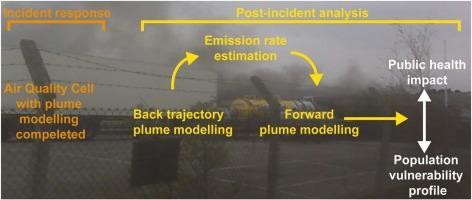Evaluating public exposure to airborne particulates from major incident fires: A back trajectory plume modelling approach
IF 11.3
1区 环境科学与生态学
Q1 ENGINEERING, ENVIRONMENTAL
引用次数: 0
Abstract
Major incident fires at industrial facilities, particularly waste sites, pose a significant risk to public health because of the large amounts of hazardous airborne pollutants released into the ambient environment. Monitoring carried out during these fires is limited in spatial resolution, meaning that the full extent of population exposure is difficult to estimate. In this study, we overcome these limitations by using a novel back-trajectory plume modelling approach, applied to PM10 emission data from a significant tyre fire that occurred in the UK in 2010. This approach allows the calculation of an hourly emission rate that is then used in the forward modelling mode to predict hourly plume concentrations. An analysis of the modelled plume indicated that, as a reasonable worst case, up to 8000 residents in areas adjacent to the fire may have been exposed to PM10 concentrations that are deemed hazardous. Moreover, a vulnerability analysis showed that the exposed population had disproportionately poorer health than the national average, thus raising concerns about environmental justice. This work highlights the need to improve regulatory controls for waste sites located near urban areas and for further research on population exposure and the health impacts of major incident fires.

评估公众暴露于重大事故火灾产生的空气微粒:一种反向轨迹羽流建模方法
工业设施,特别是废物场址发生的重大意外火灾对公众健康构成重大风险,因为大量有害的空气污染物被释放到周围环境中。在这些火灾期间进行的监测在空间分辨率上是有限的,这意味着很难估计人口暴露的全部程度。在这项研究中,我们通过使用一种新的反轨迹羽流建模方法来克服这些限制,该方法应用于2010年英国发生的一起重大轮胎火灾的PM10排放数据。这种方法可以计算每小时的排放率,然后在正演模型模式中用于预测每小时的羽流浓度。对模拟烟羽的分析表明,作为合理的最坏情况,火灾附近地区多达8000名居民可能已经暴露在被认为有害的PM10浓度中。此外,一项脆弱性分析表明,受影响人口的健康状况比全国平均水平差得多,因此引起了对环境正义的关注。这项工作突出表明,有必要改进对城市地区附近的废物场址的管制,并进一步研究人口接触和重大事故火灾对健康的影响。
本文章由计算机程序翻译,如有差异,请以英文原文为准。
求助全文
约1分钟内获得全文
求助全文
来源期刊

Journal of Hazardous Materials
工程技术-工程:环境
CiteScore
25.40
自引率
5.90%
发文量
3059
审稿时长
58 days
期刊介绍:
The Journal of Hazardous Materials serves as a global platform for promoting cutting-edge research in the field of Environmental Science and Engineering. Our publication features a wide range of articles, including full-length research papers, review articles, and perspectives, with the aim of enhancing our understanding of the dangers and risks associated with various materials concerning public health and the environment. It is important to note that the term "environmental contaminants" refers specifically to substances that pose hazardous effects through contamination, while excluding those that do not have such impacts on the environment or human health. Moreover, we emphasize the distinction between wastes and hazardous materials in order to provide further clarity on the scope of the journal. We have a keen interest in exploring specific compounds and microbial agents that have adverse effects on the environment.
 求助内容:
求助内容: 应助结果提醒方式:
应助结果提醒方式:


